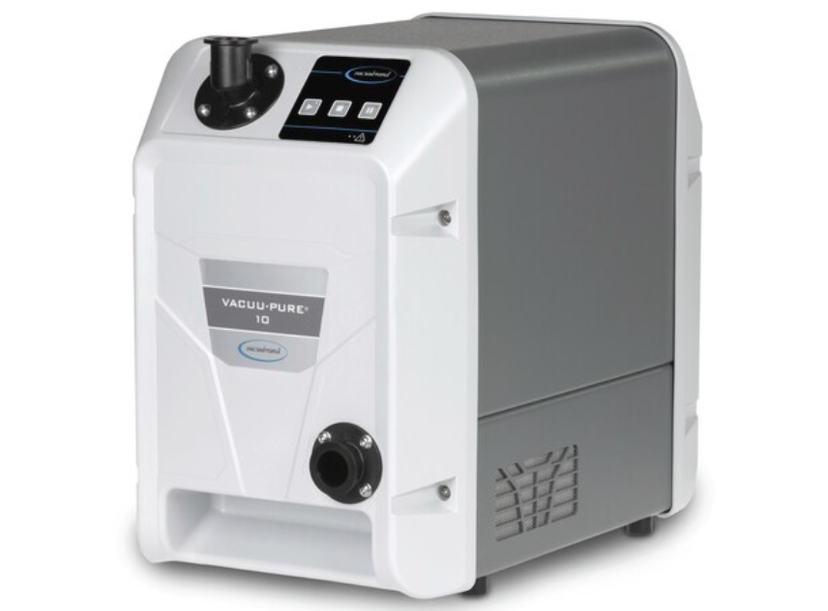State-of-the-art dry vacuum pump cuts costs and contamination
How the VACUUBRAND’S VACUU·PURE 10 and 10C dry screw vacuum pump can reduce contamination and routine maintenance for physics and materials science experiments
25 Jun 2025
Scientists working on applications in physics and materials science can improve lab workflows with the consistent long-term performance of VACUUBRAND®’s VACUU·PURE® 10C dry screw vacuum pump

Mike Mesteller, Product Marketing Manager for Vacuum at BRANDTECH Scientific
Lab vacuum systems play a crucial role in many scientific workflows, facilitating the removal of gases and debris to create the controlled, contaminant-free conditions needed for accurate and reliable scientific experiments. However, traditional vacuum technologies like rotary vane and scroll pumps often fall short, presenting challenges around maintenance, contamination, and efficiency.
VACUUBRAND’s VACUU·PURE® 10 is a state-of-the-art vacuum system that offers a promising alternative, setting new standards for contamination control and long-term reliability through its advanced screw pump technology.
Limitations of traditional vacuum pump systems
Rotary vane pumps, though commonly used, depend on oil to maintain a vacuum seal and for lubrication. In solvent-heavy workflows, this oil can easily become contaminated and oil particulates can back flow into the laboratory systems, compromising vacuum performance and results.
“Rotary vane pumps have oil directly in the flow path,” explains Mike Mesteller, VACUUBRAND Product Marketing Manager at BRANDTECH Scientific. “That means anything passing through the pump can contaminate the oil. Just like in a car, once the oil is compromised, the pump fails, often without much warning.”
Scroll pumps remove the need for oil but come with their own challenges. They rely on consumables such as tip seals - the component that maintains the seal between the scrolls by staying in constant contact during operation. These seals degrade over time, generate particulates, and require frequent maintenance. This degradation can also cause contamination and replacing them leads to lab downtime and performance variability.
“In both cases, labs face unpredictable maintenance, unplanned downtime, and recurring costs for service and parts,” says Mesteller. “That’s especially disruptive in high-precision environments like analytical chemistry and mass spectrometry, where even a trace contaminant or slight interruption can throw off results.”
VACUU·PURE® 10 dry screw vacuum pump offers breakthrough solution

VACUUBRAND has developed the VACUU·PURE® 10, a vacuum pump that’s oil-free, contactless, contamination-free, and virtually maintenance-free.
To overcome the limitations of legacy vacuum technologies, VACUUBRAND has developed the VACUU·PURE® 10, a vacuum pump that’s oil-free, contactless, contamination-free, and fully maintenance free throughout it’s useful life. At the heart of the system is a dry screw pump mechanism that operates without oil or contact between moving parts, ensuring a clean vacuum path free from particulate or chemical contamination.
“A key differentiator is the absence of internal contact seals and other components that can frequently wear down in scroll pumps, generate debris, and require regular replacement,” explains Mesteller. “By removing these entirely, the VACUU·PURE® 10 eliminates a common source of contamination and maintenance, helping ensure consistent vacuum performance”.
With a rated lifespan of up to 60,000 hours of continuous, maintenance-free operation, the VACUU·PURE® 10 significantly reduces downtime and eliminates the recurring service costs typically associated with traditional vacuum systems.
Proven performance in high-precision mass spectrometry
At the Canadian Centre for Isotopic Microanalysis (CCIM) Secondary Ion Mass Spectrometry (SIMS) Facility, at the University of Alberta, Canada, Dr. Richard Stern adopted the VACUU·PURE® 10 to support his high-resolution mass spectrometry work in geochemistry.
“We use an ion microprobe that relies on a vacuum environment to perform SIMS, a technique that requires ions to travel unimpeded by atmospheric molecules,” says Stern. “But simply generating vacuum isn't enough. For high-sensitivity instrumentation, the characteristics of the vacuum system itself and how we generate it are just as important. Reliability is key. We want to be able to ‘set and forget’ the system so we can focus on our work, not constant pump maintenance.”
Stern cites the lack of contact seals as a key reason he chose the VACUU·PURE® 10, “That was the first thing that attracted me. Contact seals wear out and require ongoing maintenance, which costs time and money. We also want to avoid particulates and hydrocarbons that could backstream into the vacuum environment.”
The VACUU·PURE® 10 was first tested on a benchtop in a controlled setup. “We gave it some tests on vacuum performance, and it did exceptionally well,” he says. “After that, we installed it into one part of our vacuum system that could be isolated if there was a problem, but it’s really not complained once. It’s very stable, both in terms of the vacuum it creates and its overall performance.”
He adds, “I have nothing but praise for the VACUU·PURE®. It’s living up to our expectations – and really exceeding them. It’s made a clear difference in the reliability of our instrumentation and reduced the service overhead considerably.”
Versatile across applications
Beyond mass spectrometry, the VACUU·PURE 10®and VACUU-PURE 10C® is invaluable across a wide range of high-performance laboratory workflows. Its robust vapor-handling capabilities, oil-free design, and exceptional chemical resistance make it ideal for processes like freeze-drying, final drying, and distillation – especially when solvent loads are high and cleanliness is critical.
“Unlike scroll pumps, which use a labyrinth-like internal structure that can trap vapors and reduce efficiency over time, the VACUU·PURE® features a linear flow path that efficiently expels vapors, ensuring reliable performance in high-vapor load environments,” says Mesteller. “This is a key reason why the University of Tennessee is using the system in helium recovery, an application that demands deep vacuum levels and excellent vapor handling.”
The system is also especially well-suited to advanced materials science and physics-based workflows, where even trace contamination can affect data integrity.
A more sustainable choice
With labs under increasing pressure to reduce their environmental footprint, sustainability is becoming a key consideration in equipment decisions. Beyond its performance advantages, the VACUU·PURE® 10 also offers benefits that make it a greener choice. “It’s completely oil-free, so there’s no need to buy, dispose of, or worry about oil spills. That removes a significant environmental and safety concern,” explains Mesteller.
He continues, “The pump also has no wear parts and is built for long-term operation. That means fewer component replacements, less waste sent to landfill, and a lower overall resource footprint. Plus, our manufacturing in Germany follows green principles, helping labs meet sustainability goals without sacrificing performance.”
Long-term vacuum performance
For labs working in contamination-sensitive or high-throughput settings, selecting the right vacuum system is a critical investment. “State-of-the-art labs need state-of-the-art tools,” says Mesteller. “Outdated pumps will affect your results and slow your progress. If your lab can’t afford downtime or compromised data, then you can’t afford to ignore these risks.”
He advises, “When evaluating vacuum systems, think long term. The upfront cost is just one part of the equation. You also have to factor in maintenance, potential downtime, replacement parts, and the risk of contamination. What really matters is the total cost of ownership."
The VACUU·PURE® 10 offers a more efficient, cost-friendly and dependable solution for modern labs, designed to keep pace with evolving scientific demands and deliver consistent performance over the long term.
Learn more about the VACUU·PURE® 10 and how it could benefit your research.

